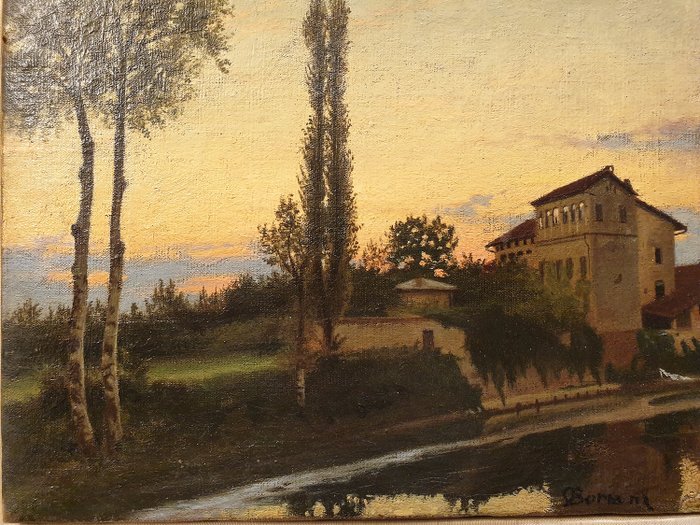
Antonino Calcagnadoro (1876-1935) - Bagnanti
N. 26450037

N. 26450037

Prezioso dipinto attr. a Odoardo Borrani (1833-1905) olio su tela (con chiavi) 20x15 cm. raffigurante una "Villa sul torrente Mugnone". Databile fine 800. Cornice a foglia d'oro zecchino coeva ed intagliata a mano in eccellenti condizioni. Fu uno dei maggiori esponenti dei Macchiaioli e i suoi dipinti ripresi dal reale sono i più ricercati e quotati. Lecita provenienza. No restauri. L'opera è priva di certificazioni di autenticità. Foto con igrandimento (lente).
Odoardo Borrani was an important member of the Macchiaioli, a mid-nineteenth century artistic movement in Italy and cultural counterpart to the political and social campaign toward Italian reunification and the cessation of foreign rule (called il Risorgimento or "The Resurgence"). For the most part, the Macchiaioli were democratic intellectuals and artists in the late 1850s who opposed the authoritarian training at the Florentine Academy. Through casual gatherings at Caffé Michelangiolo led by master baker and leftist leader Giuseppe Dolfi, they were collectively exposed to the radical politics of the working-class. Caffé Michelangiolo became the breeding ground for topics ranging from aesthetic challenges in painting, to the politically progressive goals of the Risorgimento. Ultimately, each artist participated in key events of the Italian reunification, expressing their nationalism through the "modern aesthetic idiom of landscape" (Albert Boime, "The Macchiaioli and The Risorgimento," The Macchiaioli, 1986, p. 33). The name Macchiaioli (from the Italian "macchia" – meaning "patch" or "spot"), signaled the artists identification with the sketch phase of the pictorial process, and the importance of retaining the formal qualities found in the immediacy of a sketch when creating a "finished" work. They drew inspiration from their contemporary world, creating plein-air sketches of the Tuscan countryside and the humble existence of its inhabitants. Their paintings are characterized by a distinctive treatment of light and shadow and a democratic approach to composition and form.
Around 1855, Borrani, a frequent attendee of the meetings at Caffé Michelangiolo, renounced formal training altogether and turned solely to painting outside. In the early 1860s, he and his contemporaries, including Telemaco Signorini and Silvestro Lega, banded together in their shared practice of sketching outdoors and founded the so-called Piagentina "School." It was a period of tremendous growth and creativity for the artist, who approached new ways of picturing light. In the mid-1860s, Borrani lived and worked at Castiglioncello, Diego Martelli's sprawling estate in the Maremma countryside. Martelli, a country gentleman and theorist, was instrumental in sustaining the Macchiaioli, both financially as well as intellectually, opening his grounds to the artists to live and work. At Castiglioncello, Borrani created works such as the present painting, which depicts the lifestyle of the mezzadria, the sharecropping system that was fundamental to Tuscan rural life. It was the Macchiaioli that brought this agrarian lifestyle sharply into focus in their works, exploring the aesthetic possibilities of the distinctive landscape. In his landscapes and views of the poderi (peasant farms), Borrani almost always included a peasant figure in a strong, frontal stance, engaged in some sort of labor. In the present work a young girl feeds chickens – the same subject can be seen in House and Seacoast at Castiglioncello (circa 1864). Boime writes: "With the works painted at Castiglioncello and in the Piagentina area, Borrani assumed a leading role in shaping the second phase of the Macchiaioli style: a new interest in the use of light found its proper framework in the elegant compositional structures of the Purist Tuscan tradition"
Come fare acquisti su Catawiki
1. Scopri oggetti speciali
2. Fai l’offerta più alta
3. Paga in tutta sicurezza